Truck Camper Magazine reviews an all-in-one Goal Zero Yeti Pro 4000 lithium battery system, solar controller, 110-volt inverter, and DC-to-DC converter. It all worked out, but it wasn’t exactly plug-and-play.

The lead-up to this review was published in August of 2024 as a product installation story. No sugar coating it, the Goal Zero Escape System was a bear to shoehorn into our rig. This was expected given the two-decade vintage of our camper, and the fact that no one—at that point—had attempted to retrofit the product into a truck camper with an existing electrical system.
Thankfully, the amazing team at Hallmark RV got it done, and we were able to share some hard-earned lessons in the installation story.
What should have followed is a real-world test of the system. Unfortunately, we immediately ran into significant problems with the Goal Zero Escape Ecosystem, some of which we were unable to resolve for months. During that time we worked with Goal Zero and fellow truck camper, Mike Tassinari, to develop and implement solutions. The good news—and there is good news—is that the solutions we found are successful and repeatable for anyone who adopts this system moving forward.
Before we get to the problems and solutions, I want to touch on why we had problems with the Goal Zero Escape Ecosystem in the first place. The number one reason is that the Goal Zero Escape Ecosystem was not originally designed for the RV marketplace, much less a truck camper. The product was primarily designed for residential use as a backup power system. In that context, most of the problems we encountered are not applicable.

Above: The Goal Zero Yeti 4000 is essentially an all-in-one 330Ah lithium battery, converter, solar controller, and 110-volt inverter—Photo courtesy of Goal Zero
In fact, the idea to install this system in a truck camper is partially our fault. When the Goal Zero team explained what the Yeti Pro 4000 was, we suggested that our community would be very interested in an all-in-one, high-capacity, easily expandable lithium battery and electrical system. They later proposed that we install the system in our camper. Optimistic assumptions were made on both sides, and we proceeded.
Challenge 1: A Faulty Ground
Due to a last-minute decision by Goal Zero legal making it impossible for us to conduct the installation at Goal Zero HQ, and a surprise all-hands Goal Zero meeting, we only had one day with our Goal Zero technical team during our installation. This was made worse by the fact that our time with the Goal Zero team was the first day—before we really got into the installation. We also found the installation instructions less than 100 percent clear, especially for a retrofit.
Thanks to the expertise of the Hallmark RV team, 99 percent of the installation was perfect. What we got wrong was a ground wire that the Goal Zero instructions called for. As a result, the unit bricked within hours of rolling out of the Hallmark RV factory. A phone call to Goal Zero technical support had us hard reset the unit, but we continued to experience issues related to this faulty ground for some time.
Solution: No Ground Necessary
After weeks of related issues, Goal Zero technical support had us remove the ground. We were told the unit is self-grounding and does not need to be grounded in an RV application. Removing the ground solved this problem. This challenge should not plague future owners as Goal Zero support is now fully aware of this and—according to their feedback—has made the instructions clearer.
Challenge 2: The Main Unit and Expansion Battery Would Not Sync
The concept of the Yeti Pro 4000 and the partnering Tank Pro 4000 expansion battery is that the batteries will “sync” and behave as one large battery bank. How does this “sync” happen? Well, the Goal Zero team explained that it should just happen as the system is used and charges back over time. So we kept an eye on the Goal Zero app and waited. And waited. And waited. After a couple of weeks, we still had no Justin, JC, Joey, Lance, or Chris. NSYNC? Nope.
What was more troubling was that it appeared the main Yeti Pro 4000 was pulling power from the Tank but not allowing the Tank to charge via solar. With 490 watts of solar on our roof, we never even thought about plugging into shore power. That’s the whole idea of having such a system.
Solution: Plug Into 30A Shore Power
Long story short, the answer was plugging the camper into 30-amp shore power. Once we plugged into 30-amps for a few days, the sync problem was bye-bye-bye.
Even better, the two units have stayed in sync ever since. Hopefully, this also gets into the instruction manual. As is often the case with so many things, several of the challenges could have been avoided with better instructions.
Challenge 3: Solar Controller Clicking
I often joke about how this magazine will end. For example, Angela and I will be making a rather precarious turn on the cliff side of a mountain, and I’ll say, “This could be the answer to the question, ‘Whatever happened to Truck Camper Magazine?’” Angela never laughs, probably because I’m driving when I say these things.
Anyway, the Goal Zero Yeti Pro 4000 has a built-in solar controller. As part of the installation, we spliced the solar panel leads coming from our roof to Goal Zero’s purpose-made wires and then directly into the appropriate input on the Yeti Pro 4000. Bingo! The solar charged the system’s lithium batteries.
Unfortunately, the solar controller in the Yeti Pro 4000 clicks at dawn and dusk as it gets just enough solar to change (click), and then doesn’t (click). This click was loud enough to wake us up at 5:30am. This click was loud enough to drive us over the proverbial edge. Whatever happened to Truck Camper Magazine? Click!
With wild hair, red eyes, and sweaty brows, we brought this concern to Goal Zero’s attention and guess what? There’s no simple solution. As long as the solar panels and connected to the solar controller on the Yeti Pro 4000, it’s going to click at dawn and dusk. Every few seconds—click!
Solution: Install a 30-Amp Switch
Our first solution was to unplug the solar input at dusk and plug it back in every morning. This was less than convenient given the configuration of the installation, but it sure beat the cat waking up at 5:30am, walking on our heads as additional clicks followed, and the three of us becoming off-grid and out-of-our-mind lunatics before sunrise. Yes, that happened. Click!
We needed a reliable work around solution before our camper went over the funny farm falls. And who’s the undisputed master of reliable work around solutions in the Truck Camper Magazine rolodex? None other than Mike Tassinari—aka Mikeee of the North-East Truck Camping Jamboree. Clever, creative, and relentless he is.
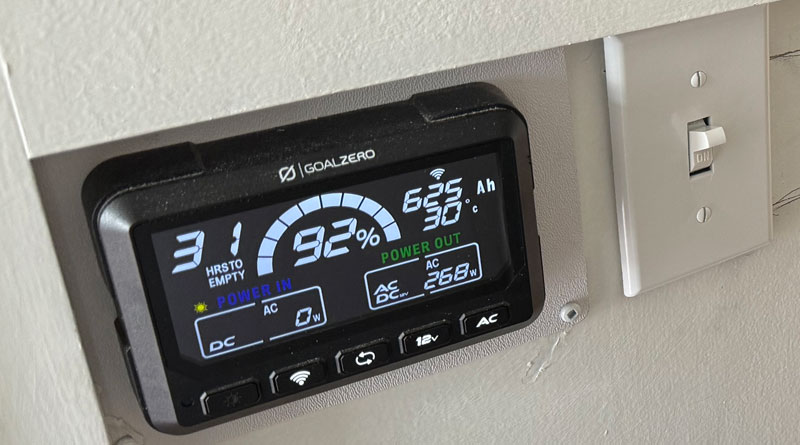
Above: The solar switch is to the right of the Goal Zero info screen
Mikeee took a look at our set-up, we went to Home Depot, bought a 30 Amp switch, installed it between our solar panels and the Goal Zero system, and strongly hinted at an ice cream reward. Like the ice cream that followed, the solution worked like a treat. We now have a conveniently located 30-amp switch that we turn off at the first click of the evening, and turn on the next morning. Easy peasy.
Thank you, Mikeee. You may have saved the magazine.
Challenge 4: Unable To Power Four Corner Jacks
Imagine our surprise (and horror) when our 630-amp hour Goal Zero lithium battery system couldn’t power our Rieco-Titan corner jack system. This was potentially the torpedo under the water line of truck camper viability for the Goal Zero Escape Ecosystem. I mean, we’ve had campers with lead acid Group 27 batteries that successfully powered the Rieco-Titan jacks. Why in the heck couldn’t this mondo Goal Zero lithium battery system power a set of four corner jacks?
Well, it turns out the 12-volt output of the Goal Zero system was—shall we say—under spec’d for this application. A Rieco-Titan jack system requires upwards of 60-amps on tap to run all four jacks. Whatever the Goal Zero system offered, it was barely enough to run one electric jack.
Solution: 110-Volt to 12-Volt Switching Power Supply
Goal Zero support recommended an external 110-volt to 12-volt switching power supply. When we brought that idea to Mikeee, he found a switching power supply on Amazon that he believed would do the trick. Always happy to spend our money, Mikeee told us what to order.
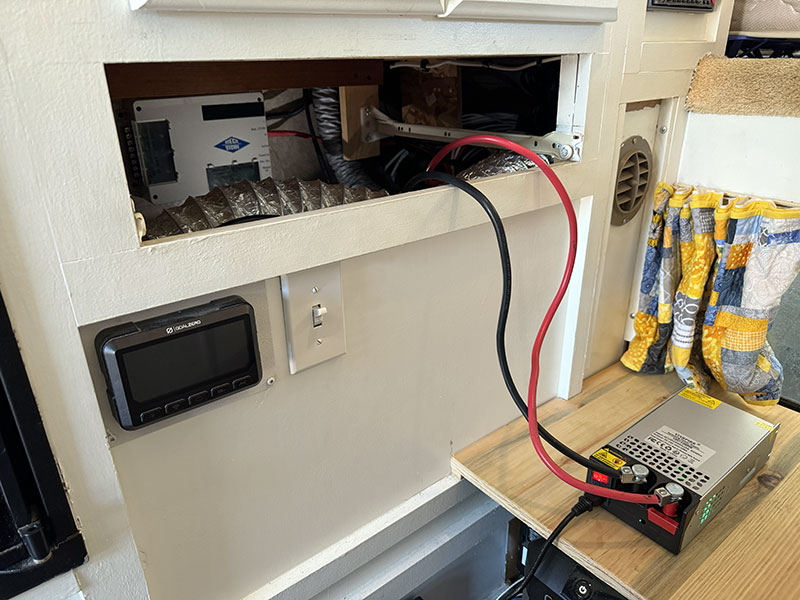
In a nutshell, the external 12-volt switching power supply (shown above) would connect to a 110-volt outlet on the front of the Goal Zero Yeti Pro 4000 and convert that power to 100-amps of 12-volt power.
When the switching power supply arrived, it was fairly straightforward to install a set of appropriate connectors to the Rieco-Titan power input wires, connect the switching power supply, plug the switching power supply into the Goal Zero, and turn on the switching power supply.
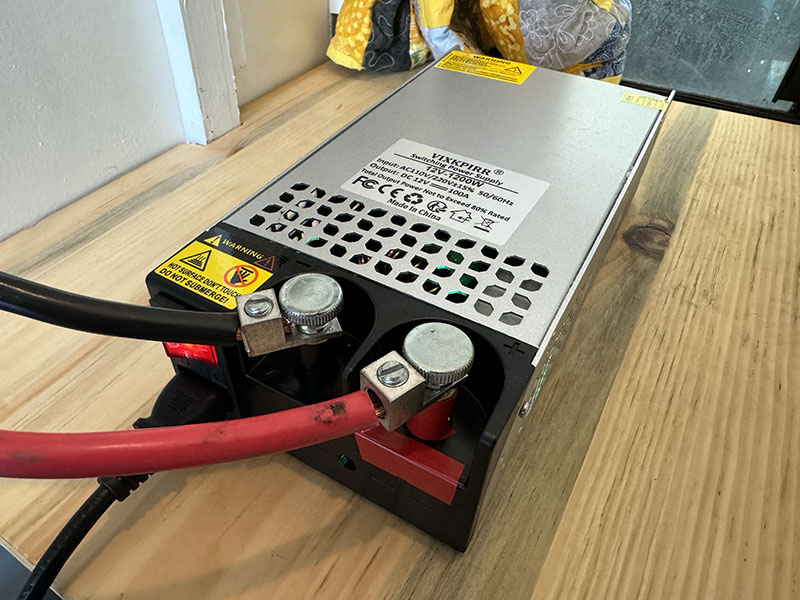
What happened next had our collected socks rolling up and down. With 100-amps of power behind them, the Rieco-Titan jacks ran with better speed and authority than they did on our AGM batteries. I realize it’s odd to get excited about camper jacks running efficiently, but even Mikeee was talking about getting the same 12-volt switching power supply to better power his jacks. This solution is a bit of a hassle to set up every time we want to run our jacks, but it works incredibly well.
Challenge 5: DC-to-DC System Draw and Power
For reasons we’re still not completely sure of, we were originally under the impression from Goal Zero that the DC-to-DC charger in the Yeti Pro 4000 would pull from the truck battery until the truck battery was technically dead (11.8 volts). We were later informed that the DC-to-DC charger would stop pulling at 12.3 volts (much better). This may have been fixed in a software update, or it may have been incorrectly communicated information that was resolved.
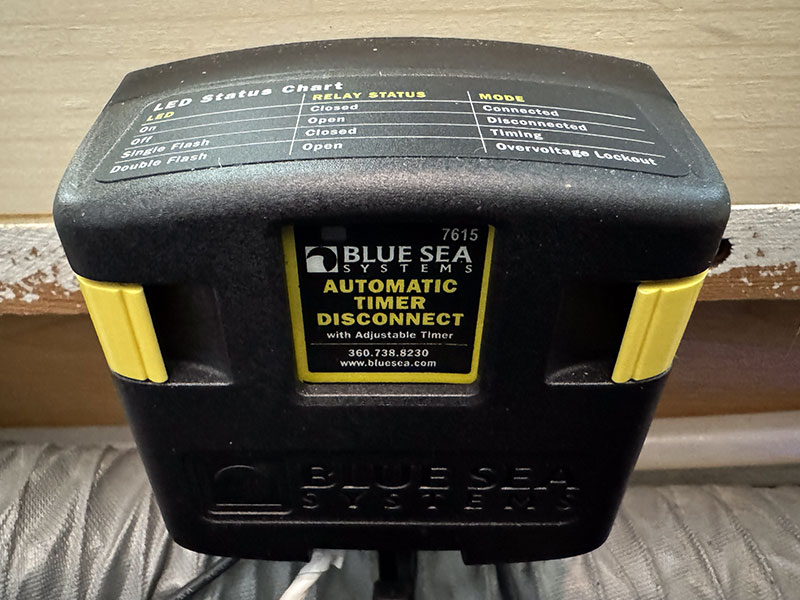
To cover our bets, Mikeee Tassinari helped us to install a Blue Sea battery isolator and set it to disconnect from the truck battery at 12.75 volts. This solution worked, but the Blue Sea unit immediately started to click in a similar manner to the solar charger. It seems we’re clickbait.
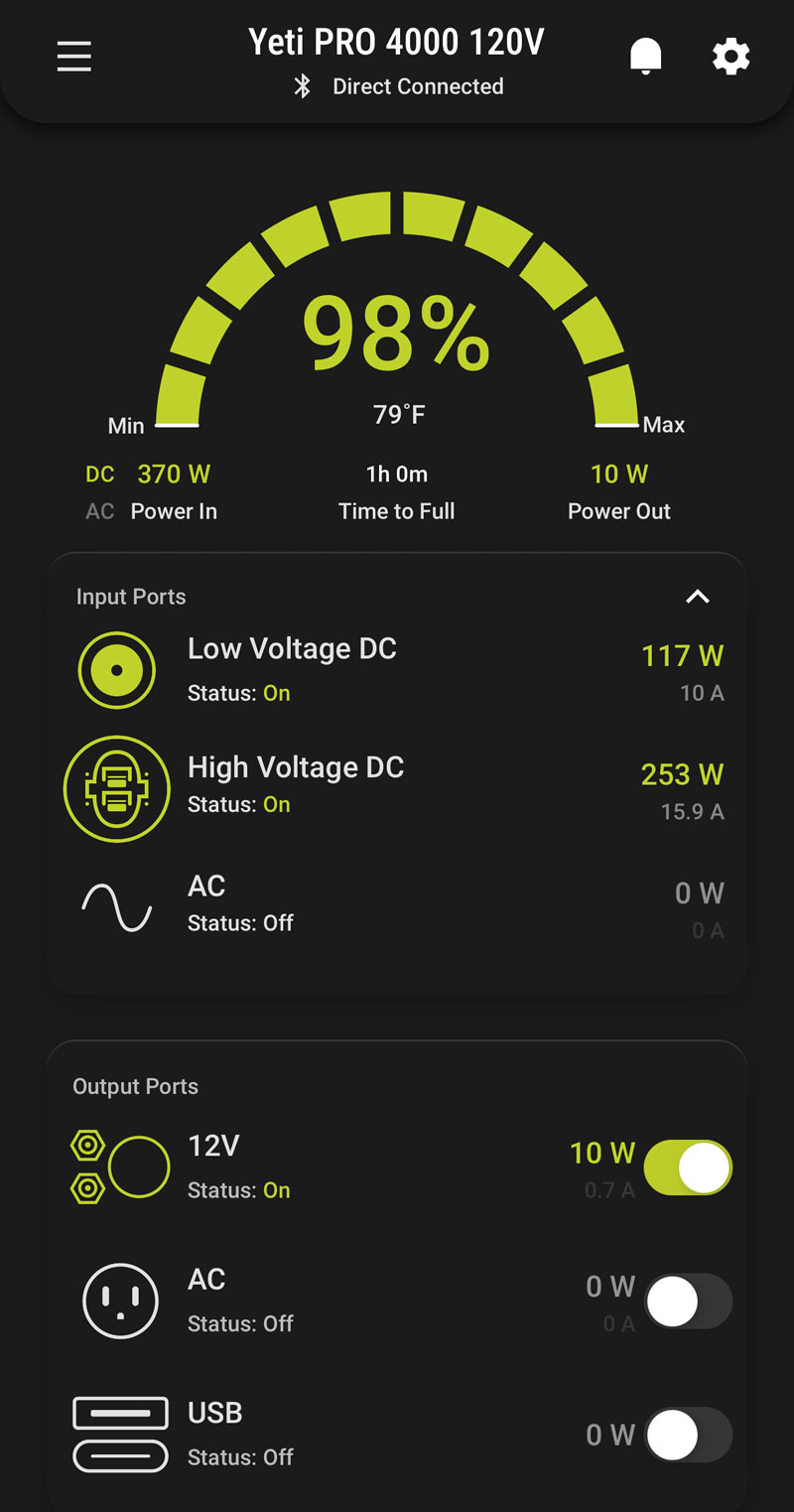
Above: This screen cap from the Goal Zero app shows the low voltage DC-to-DC
While traveling, we rarely saw more than 120 watts from the DC-to-DC charger. Mostly it stayed in the 75 to 120 watt range. Competing DC-to-DC chargers output between 200 and 750 watts making us suspect that the DC-to-DC charger in the Goal Zero Yeti Pro 4000—like the 12-volt output—was under spec’d.
Solution: Disconnect the DC-to-DC
We ultimately decided the DC-to-DC in the Yeti Pro 4000 wasn’t worth using. With 490-watts of solar on the roof keeping the lithium batteries topped off, it isn’t needed anyway. Hopefully, Goal Zero addresses this aspect of the Escape System as it’s vital to many truck camper rigs.
Challenge 6: Solar Wire Melted
After we got the DC-to-DC situation settled, we were excited to have what we believed was a fully functional and reliable battery and electrical system again. Then the solar charging stopped.
At first, we found the solar input would work again if we unplugged the solar input wire and plugged it back in. That solution stopped working a few days later. Without solar charging our batteries, our shore power-free truck camping lifestyle would be challenged.
Yet another call to Goal Zero support diagnosed the problem. The Goal Zero solar wire had melted and fused together. According to Goal Zero, there was no danger with the way the cable had melted, but it rendered the cable inoperable. Goal Zero had recently become aware of this issue and advised us to use shore power until they sent us an updated cable.
The updated cable would not be available until October, which turned into December due to supply chain issues. For the rest of our 2024 trip, we found shore power once a week and charged up the Goal Zero battery bank. Lucky for us, we could go for quite a long time on 630-amp hours, especially if we refrained from using our induction cooktop and otherwise minimized our use of 110V to charge our laptops.
Solution: New Goal Zero Solar Cable
Alas, the new solar cable arrived in December and has worked perfectly. This should not be a problem for anyone buying a new Goal Zero Escape system as they will get the updated cable. And Goal Zero reported that they had already reached out to existing customers and were replacing their cables.
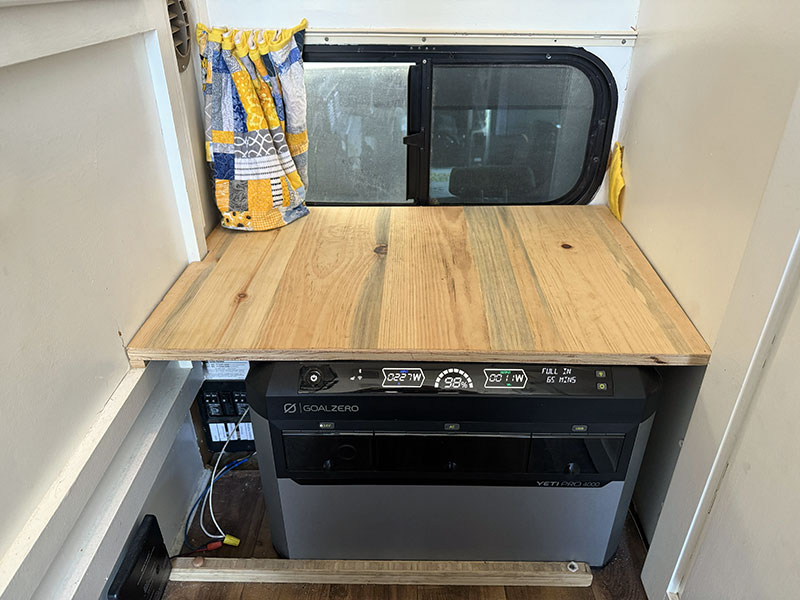
Above: We plan to cover the board in linoleum or carpeting, but it works for now
If we started today with the Goal Zero Escape System and performed all of the above solutions from the start, we would have no issues. We have 630-amp hours of lithium batteries on board and excellent solar charging capability from our 490-watts of solar. We can turn on the Goal Zero system’s inverter and have 110-volt power at every outlet in the camper. That last benefit has been a game changer as we charge our computers at will, use our induction cooktop instead of propane, and turn our refrigerator on AC for ferries and tunnels. Having this much lithium power and an inverter is addictive.
And yes, we can run our Coleman Mach 8 air conditioner for approximately six hours. I’m not a huge fan of this idea because it leaves you with a depleted battery, but the capability is there. If we get the opportunity to try an efficient 12-volt air conditioner, that should be the final puzzle piece to truly unlock off-grid air conditioning. Until then, this capability is there to cool down the camper for a few minutes or for an emergency situation.
My sincerest hope is that Goal Zero comes out with a second-generation Yeti Pro 4000 system that solves all of these challenges from the ground up. Ideally, that system would have an excellent manual including installation and troubleshooting, a silent solar controller, at least a 60-amp capability for the 12-volt output, and a better DC-to-DC implementation. Oh, and make the unit smaller and lighter. While we’re at it, make expansion batteries the same size as Group 27 and Group 31 batteries so we can put them where our existing batteries go. One can dream.
I want to thank the Goal Zero team for being patient with us during this process and working tirelessly to help us with the needed solutions. Now that the system is settled in our camper, it’s incredible to have so much power and capability on tap. Once you have this level of lithium power at your fingertips, it’s hard to go back.
For more information about the Goal Zero Escape Ecosystem, visit goalzero.com.
